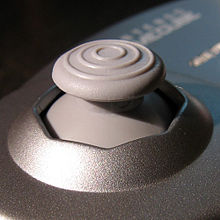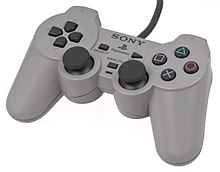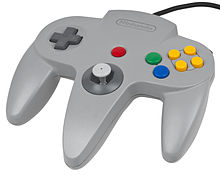Analog stick
An analog stick (also called an analog stick, control stick or control stick ) is an input device for a game controller (often a gamepad ) for two-dimensional signals. This can be tilted in several directions. The functionality of an analog stick is very similar to that of a joystick .
The analog stick has largely replaced the control pad in computer games , both in terms of popularity and number of uses.
functionality
The signal that the stick generates is based on the position of the stick as a function of the standard position. While digital sticks such as control crosses are based on individual electrical signals when actuated (short electrical signals are generated via internal contacts for the four directions up, down, left and right), analog sticks use continuous electrical voltages that are regulated by a potentiometer become. One potentiometer each measures the position left / right or up / down. Changing the position of the analog stick changes the voltage. The position of the stick can be determined on the basis of the two current voltages. The N64 controller is an exception due to its functionality: In the original, a counting disc is scanned by two light barriers. They are aligned in such a way that they generate alternating pulses depending on the direction of rotation. These are converted into an absolute position by the chip on the controller's motherboard.
Use in computer games
In a computer game, an analog stick is often used to move a game object, usually the character . It is also used to rotate the camera, usually around the character. The analog stick can have a variety of other functions, depending on the game. Many modern analog sticks can also be pressed like other buttons on the controller.
The analog stick is mainly used in 3D games where more than eight directions are necessary (eight directions are made possible by the directional pad). Using a directional pad in a 3D game severely limits your ability to move. In a 3D platform game like Super Mario 64 , for example , it would only be possible to move forwards, left and front-left with a control pad, but not in between. This was exactly the case in the port for the DS, because the DS did not have an analog stick. Some early 3D games like Resident Evil overcame this limitation by using the left and right of the D-Pad to rotate the character instead of moving. However, this caused problems of its own because the character was unable to move while rotating. With the spread of the analog stick, the aforementioned problems with the control pad became a thing of the past.
Dual analog sticks
Two analog sticks allow more functions and applications than one. On many modern gamepads, the first left stick is attached to the left above the directional pad, while the second right stick is to the left below the buttons. Gamepads with this arrangement are for example the Nintendo GameCube , Xbox and Xbox 360 controllers .
Some gamepads instead have the two analog sticks in a symmetrical arrangement with the directional pad on the top left and the buttons on the top right. Sony's PlayStation game pads - the dual analog controller , DualShock , DualShock 2 , Sixaxis, and DualShock 3 - all use this arrangement. The Wii Classic Controller also makes use of this constellation. The original Wii U GamePad had two analog "Circle Pads" positioned symmetrically above the D-pad and buttons, but has been reconfigured and now has two clickable analog sticks.
In genres such as action , adventure , platform games and third-person shooters , the left stick usually controls the character, while the second stick controls the camera. The second stick alleviates the problem of many previous platform games where the camera was notoriously inappropriately positioned. The right stick is also important for most modern first-person shooters like Halo , where it controls the direction of gaze and aiming, while the left stick controls the movement of the character. In Namco's Katamari Damacy and its successors, both analog sticks are used simultaneously to control the character.
Sony's PlayStation Portable has been criticized for the lack of a second analog "Knubbels". This criticism later also hit Nintendo's Nintendo 3DS . Nintendo has now released an add-on for the 3DS that can be purchased, including a second analog "Circle Pad". The successor to the Sony PSP, the PlayStation Vita , is the first handheld console that has two analog sticks.
history
The first game console with an analog joystick controller was the 1292 Advanced Programmable Video System , released in 1976. The 2 sticks each used a pair of potentiometers but were not self-centering.
In 1982, Atari released their first controller with a potentiometer-based analog joystick for their Atari 5200 home console. However, the non-self-centering joystick design proved clumsy and unreliable. During this time General Consumer Electronics introduced the Vectrex , a vector graphics- based system that used a self-centering analog stick. For many years, consoles ignored analog technology and used the digital control pad instead. Only the advent of 3D graphics and the game mechanics that came with them led to the widespread use of the analog stick.
In 1985, Sega's third-person rail shooter game Space Harrier , released for arcade systems , introduced a true analog flight stick . It could register movements in every direction as well as the degree of pressure. This allowed the character to be moved at different speeds, depending on how hard the joystick was pressed in a certain direction.
On April 26, 1996, Sony released a potentiometer-based analog joystick for use in flight simulation games. The Sony Dual Analog Flightstick had two analog sticks and was used in games like Descent to allow a greater degree of freedom of movement than typical digital joysticks of the time.
Originally announced for April 21, 1996, Nintendo did not release the Nintendo 64 and its controller until June 24, 1996, making it the first standard gamepad for a console with an analog stick. The new controller included a thumb-controlled control stick (the stick works on the same principle as a mechanical computer mouse) that allows for different levels of movement and almost 360-degree control, and translates the signals into much more precise movements than it does would be possible with a control pad.
On July 5, 1996, Sega released the game Nights into Dreams ... for their Saturn console in Japan, which came in a package with the Saturn 3D control pad, which had an analog pad to give the player more control over the flight-based game mechanics . The analog pad was less complicated to build compared to its contemporaries because it had a Hall sensor that served as the basis of the Dreamcast controller.
On April 25, 1997, Sony released a similar analog stick based on the same potentiometer technology used in the larger dual analog flight stick. The Sony Dual Analog Controller supported force feedback, three analog modes (flight stick, full analog and analog switched off), as well as two concave thumb sticks, while Nintendo and Segas controllers only had one stick each.
On November 20, 1997, Sony released its third analog controller, the DualShock . The controller had twin sticks similar to the dual analog controller, but these were convex and rubberized instead of plastic. Sony also removed the third analog (flight stick) mode and added two new buttons under the analog sticks that could be operated by pressing the sticks.
In 1999, Sony's Ape Escape became the first computer game that required two analog sticks to play.
In the game console generations that followed, most game controllers have two analog sticks, with the exception of the Dreamcast console. Other exceptions to this dual stick rule are Sony's PlayStation Portable and the Nintendo 3DS handheld console (although the latter can be expanded with a second stick through an optional hardware upgrade), both of which only have a small analog trackpoint . The New Nintendo 3DS now also has a second stick in the form of a trackpoint, similar to the one used as an input device on older laptops. Sony's PlayStation Vita also has two analog sticks again.
Problems
In the past, it was often the case with analog sticks that the plastic wore out and the sticks became more and more worn out over time. This is particularly the case with the N64 controller. However, today's analog sticks are usually much more robust.
With some analog sticks, the rubber covers wear out after prolonged intensive use. One of the consequences of this is that you can no longer steer so precisely. To solve this problem, new rubber coatings must be applied to the sticks. For example, this is the case for an estimated 10% of the first run of the DualShock4 controller .
When using some analog sticks, the game figure moves even though no input is made. It often helps if you inject so-called contact spray into the recess for the sticks to clean the contacts. However, it must be ensured that the manufacturer expressly points out that the spray also works with electronics. If this is not the case, it can happen that the contacts of the analog sticks break and the sticks no longer react to any input. This problem occurs quite often with the Joy-Con of the Nintendo Switch (called Joy-Con-Drift), most likely because they are very small and for that reason alone have little leeway when moving, so that there is already little dirt in the gaps between the sticks can ensure that these no longer work as desired.
See also
Individual evidence
- ^ Maximilian Walter: Wii U - Nintendo introduces "hardcore" controllers and social networks. In: GamePro. June 4, 2012. Retrieved November 29, 2013 .
- ^ TGS 2004: Ape Escape Academics Hands-On . IGN. September 24, 2004. Retrieved December 14, 2007.
- ↑ PlayStation Vita Impressions . GamerPops. February 22, 2012. Archived from the original on October 5, 2012. Retrieved on October 15, 2012.
- ↑ by SinfulSoxfan84: Resistance: Burning Skies Review - Blog by Jamiemad66 . IGN. June 10, 2012. Retrieved October 15, 2012.
- ↑ Gamechanger or Game Ender? . Broowaha. Retrieved October 15, 2012.
- ^ Space Harrier Retrospective , IGN.
- ↑ a b c SCPH. In: maru-chang.org. Retrieved November 29, 2013 .
- ^ Coverage of the Nintendo Ultra 64 Debut from . Game Zero. April 21, 1996. Retrieved October 15, 2012.
- ↑ Controller's History Dynamite from . 1UP.com. Retrieved October 15, 2012.
- ↑ Sega Saturn 3D Pad - What's inside? . NFG. October 20, 2008. Retrieved September 14, 2011.
- ↑ Published by Johannes Domke: N64 controller change analog stick: Instructions for changing the joystick. November 23, 2016, accessed on April 18, 2019 (German).
- ↑ Sony Responds To DualShock 4 Wearing & Tearing - TheSixthAxis. Retrieved April 18, 2019 (American English).
- ↑ Nintendo Life: Guide: How To Fix A Drifting Nintendo Switch Joy-Con Analogue Stick. July 16, 2019, Retrieved July 18, 2019 (UK English).
- ↑ Players are angry about defective controllers - Joy Con drift spoils the gaming experience. July 17, 2019, accessed July 18, 2019 .
- ↑ Benjamin Jakobs: Nintendo Switch: "Joy-Con Drift" is apparently becoming more and more of a problem. In: Eurogamer.de. July 17, 2019, accessed July 18, 2019 .
- ↑ Gita Jackson: Joy-Con Drift Is Becoming A Real Problem On The Switch. Retrieved July 18, 2019 (American English).


